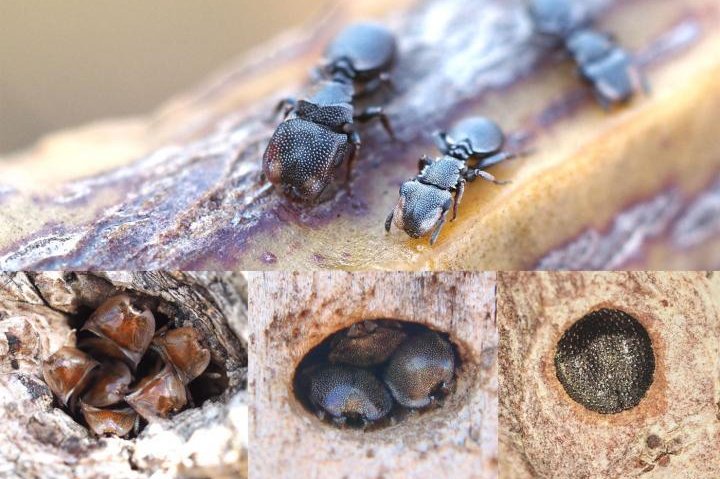
Turtle ant soldiers have evolved a variety of head shapes to block the entrance to their tunneled tree nests. Photo by Scott Powell/George Washington University
March 10 (UPI) -- Turtle ant soldiers have evolved a unique defensive strategy. These gate guards use their comically large heads to block entrances to their nests.
Some ants have round heads, like a manhole cover, ideal for blocking a small round entrance. Other ants, with square heads, congregate to form a blockade, like the wall of overlapping shields formed by Spartan armies.
Turtle ant soldiers seem like a perfect example of evolutionary specialization. The many species of the turtle ant genus occupy specific niches. But a new study of turtle ant soldiers suggests evolution doesn't only encourage specialization.
Instead, scientists uncovered evidence that evolution can promote regression toward a more generalist approach.
"Usually, you would think that once a species is specialized, it's stuck in that very narrow niche," Daniel Kronauer, head of the Laboratory of Social Evolution and Behavior at Rockefeller University, said in a news release. "But turtle ants are an interesting case of a very dynamic evolutionary trajectory, with a lot of back and forth."
Turtle ants make their homes in abandoned tunnels that were carved by wood-boring beetles. Different turtle ant species have evolved to occupy and defend different sized tunnels.
"There's a whopping four-fold difference between the smallest and largest turtle ant soldier heads," said Scott Powell, a biologist at George Washington University. "To help people picture this, I often say that the smallest species is able to sit comfortably on the head of the largest species."
RELATED Some fire ant colonies are ruled by multiple queens
To better understand how turtle ants diversify to fill the various niches of uniquely sized tree tunnels, scientists classified different turtle ant species by the shapes of their soldiers' heads: square, dome, disc or dish-shaped. Next, scientist used genetic data to untangle the evolutionary relationship between different species.
If evolution moved in just one direction, turtle ants should have started out without specialized soldier. And the earliest soldiers should have boasted simple square heads. Highly specialized shapes should have come only later.
Scientists found the oldest turtle ant ancestor did have square-headed soldiers. As well, turtle ants and their soldiers quickly diversified to adapt to variety of tunnels with unusually shaped heads. However, many newer species have since reversed course, having evolved more generalized head shapes, allowing them to occupy a variety of tunnels.
The new research, published this week in the journal PNAS, suggests evolution is a two-way street.
"The space that evolution has to play with is actually quite a bit larger than previously thought," Kronauer adds.
No comments:
Post a Comment